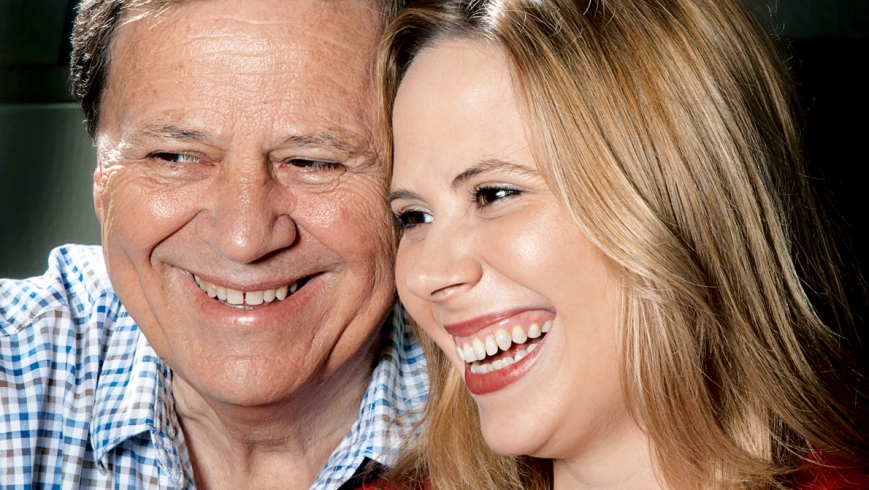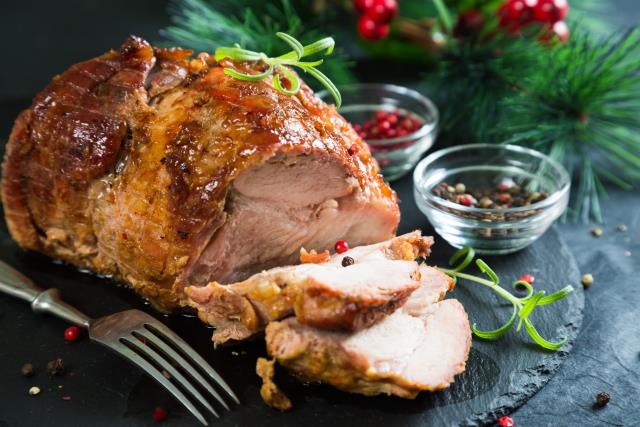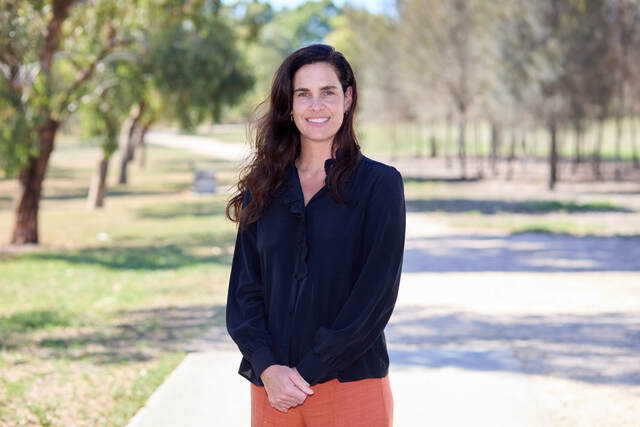She’s thousands of kilometres away, on a small screen, but from where I sit it’s evident this is a father-daughter relationship based on mutual respect, sense of humour and a shared passion for writing.
I’ve been allowed a glimpse of the Martin household, in Ray and Di Martin’s gracious home on Sydney’s north shore. On a computer screen in front of us is Jenna, Martin’s 29-year-old daughter, Skyping from Los Angeles (thanks to the technological prowess of Jenna’s younger brother Luke, 23, who wants to be an actor).
Both Ray and Jenna have recently released books – Ray’s is a collection of photographs he has taken over 40 years, and Jenna’s is a novel about being the daughter of a famous Australian, with sly parodies of the entertainment industry. Hmm, autobiographical?
“We have this running joke,” says Martin senior. “When I found she was doing the book I said, ‘What’s it about?’ and she told me roughly and I said, ‘You’re out of the will – straight up’.’’
He already knows a bit about his daughter’s book. “It’s satirical. It’s a book that really is meant to take the piss.” He looks at the screen. “She’s nodding. I’m not quite sure how much of that there is. I trust her!”
After almost 50 years in the media, Ray Martin still seems to be everywhere – filing stories for 60 Minutes and A Current Affair, doing things for SBS and the ABC (including 7.30 and Q&A,), appearing on The Project and writing books (four in three years). At 69, he’s busier than ever and is ready to talk about a little-known passion – photography.
But first let’s talk about Jenna. Her novel Driving Under the Influence stars a man who is “very, very famous … the most famous face in the country for most of my childhood. There was Paul Hogan, Don Lane and ‘Turbo’ Turbiton,” she writes.
The fictitious Gary “Turbo” Turbiton is a fading star of stage and screen who offers the novel’s young woman protagonist a job as his assistant while he travels Australia promoting an autobiography. Looks like Ray Martin is out of the woods. Maybe. “I spent two months three years ago working for dad as a producer after getting sick of ripping tickets at a box office,” Jenna says.
“I had this great experience of being on the road and seeing dad and the way people respond to him. I’ve always known what it’s like growing up with a famous father, but seeing as an adult the effect that he had, that the reach is still there and how much love is still there, and how that has affected me in my life.”
Jenna has always written and her book came about after a pitch to Melbourne University Publishing. “I was in LA working for a television company but not doing a lot that was creative,” she says. “I sent the idea to MUP and they said, “Great. Can you write 10,000 words?’ Which I did. Then it was go.”
Elements of autobiography? “The basic biographical details are the same in that I spent three years living in London, I worked in a theatre box office, I worked as a television producer on and off, but I’ve taken a lot of liberties beyond that point,” she says.
“The whole set-up of the story is completely fictional. My life didn’t go to crap quite as much as my character’s did.”
Ray Martin will have to wait until this week, like the rest of us, to read the book. “I read two chapters to him out loud over dinner,” says Jenna, “but that’s all.”
Martin senior has watched Jenna’s writing skills develop. “She’s seen me in this writing world, which has been my life, apart from appearing on television. Words were played around the house and she grew up with that. She’s a lovely writer.”
Writing competed with Jenna’s desire to act and she went to drama school in London for three years. “[To act] was my plan,” she says. “Before that I always used to write because I was frightened of getting on stage and frightened of drawing attention to myself, because there was a lot of attention on me anyway because of who dad was. [But] I got over that and really loved it.
She says she’s got to the point where’s she’s “OK with the fact that I have had the life that I’ve had’’.
“I think I finally got to the point where I thought, I can’t change the fact that my father is well known, I can’t change the fact that there are people out there who are going to judge me for that.”
For the most part, she enjoyed the perks of growing up with a much-loved famous father. “You can’t help when you go to The Midday Show set and see Nicole Kidman walking past and Russell Crowe with his Oscar and not think, ‘God, that looks like a fun world’. I went to dinner with Tom Cruise when I was 17, the one really major celebrity encounter I had as a child.”
She’d watch her father routinely scouring the newspapers in the morning. “Every morning thumbing through it with peanut butter on one hand and honey on the other as he was eating his toast,’’ she says. “The wonderful thing about mum and dad is that I never felt we were treated as kids. I never felt we were forced to grow up, but we were never excluded from their world and things that were going on.”
Part of this fascinating life is chronicled in Ray Martin’s World, a collection of photographs Martin has taken since his career started at the ABC in 1965. There’s Elton John, unrecognised in Shanghai; Lee Marvin fishing for giant marlin; a smiling David Attenborough; Ronnie Biggs wielding a movie camera; landscapes, streetscapes, animals, slices of life.
His passion began when he started taking shots of his family. “I took photos of Di until she got sick of that as the kids got sick of it. And I ran out of bribes, so then I had to take photographs of landscapes. It probably gives me more pleasure than writing these days, which is an extreme thing to say.
“We’ve just been on holidays with Luke, his friend, Jenna, Di and I, in Paris – three weeks. I get the ultimatum from the family: this is not a Ray Martin photo shoot, this is a family holiday,’’ he says.
“I’m a street photographer only because I have to be. I shoot on the run, with 60 Minutes or other assignments I’ve got. I can’t wait for the moment. I’ve just got to do it, like some of the great photojournalists.
“The passion has grown with digital because I’m an absolute instant freak, so the idea of taking it and seeing it without having to process it, and play with it and being able to tickle things on the camera because I want a certain effect; that’s added to this addiction. And it’s like what Ian Chappell said about cricket – the more I practise, the luckier I get.”
Photography wasn’t a childhood passion. “We never had cameras at home, not even a box Brownie. There are scattered photos of us as a family, working-class, other things to pay for rather than cameras. Di and I have been married 40-plus years, and all of that time I have travelled with a camera,’’ he says.
“In the 60 Minutes days I was always attacked by the cameraman and the producers for having a camera in my hand.”
“I was there to report, so I felt a bit embarrassed and a bit guilty about lugging a camera around, especially as they were a bit bigger in those days.
“Now, because of iPhones, everyone has one – the producers, the soundos – so I’m in my element.”
Martin admits he often had to be brought back to the 60 Minutes set because he was off taking photographs. “It’s ringing in my ear, a producer saying ‘We’ve got to do this interview, where’s Ray?’ ”
But he has regrets. “I did 10,000 interviews on Midday and other programs. And even Fred Hollows, one of my great heroes – I didn’t take any photos of Fred. I took photos at Fred’s funeral, but I always felt guilty [not having taken more]. Audrey Hepburn. Don Bradman; I was with Bradman for a week for that interview and I never took a photo of him. I just thought I was there to report rather than take photographs,’’ Martin says.
“I did a series last year with David Attenborough and we did 24 live shows. I had no hesitation in saying, ‘David, can I take some photos?’ and he said, ‘Yeah!’ –now I wish I had done that with all these people over the years. I’ve done every prime minister, every president since Lyndon Johnson and I never photographed them because I’d feel like a goose.”
Martin has never stopped feeling blessed he became a journalist. “I was going to be a history teacher … but I can’t believe I jumped the fence and joined this crazy circus,” he says. “After 45 years, I still pinch myself and say, ‘I can’t believe people are paying you a salary to meet these people’. What we do is dreamtime stuff.”
Martin’s next project is a book about Fred Hollows. He is travelling to Malawi in Africa with Steve McCurry, the American photojournalist who took the famous shot of the Afghan girl with the sea-green eyes that appeared on the cover of National Geographic. He is also hosting a project for SBS under the Who Do You Think You Are? banner involving Aboriginal Australia.
He will, undoubtedly, take his camera as he adds to his already long CV. “Now I’ve got a book out I can actually put ‘photographer’ on my business card.”
READ » Driving Under the Influence by Jenna Martin, $29.99 (MUP) » Ray Martin’s World by Ray Martin, $45 (Victory Books)







